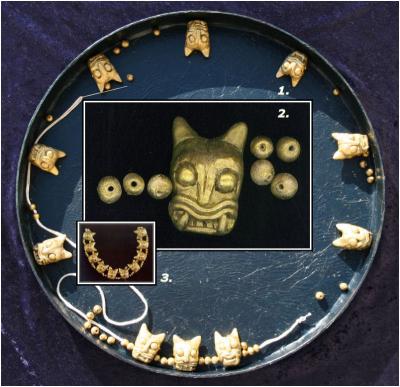« Scared of Color |Main | Four Corners »
Pre-Columbian Jaguar Beads
February 1, 2007
1. the tray 2. the beads 3. a picture of the original necklace.
The Pre-Columbian Jaguar Beads are made of Polymer clay, a permanent material once baked, acrylic paints, varnish, tray re-purposed and paper-mached, painted and varnished for durability.
I was drawn immediately to this Pre-Columbian Mayan necklacewith jaguar beads upon seeing a photo of it, and would love to own it. Well, making one is the next best thing! The original necklace of gold jaguar head-shaped beads was made over 500 years ago, discovered in a tomb in Guatemala.
Like much of the pre-historic and tribal art that looks crude or seems like it should be easy to recreate, there is a lot more here than meets the eye. One of the things that’s so enjoyable about a project like this is experiencing the same design dilemmas that the original artist might have encountered.
There is a lot of good design in that simple-looking necklace! I think the goldsmith who created the original might have used a mold because each individual jaguar head-shaped bead needs to be identical, and so do the small round ones in order to string the beads together and obtain the exact uniform semi-circle shape. Mine were individually shaped, less than perfect, and did not fit together well unfortunately. I’ll need to make a mold from one of the more perfect beads in order to replicate this with consistancy.
The jaguar beads are glued onto a useful tray, a recycled film case that was paper mached then painted with acrylic, and it’s as if a moment in time is recaptured, a moment when the original artist had beads on a surface, ready to be strung together. The refurbished tray is varnished, durable and useful. Hand wash gently with damp soapy cloth, and the crevices with a wet paintbrush, dabbing the area softly to absorb excess moisture.
Categories: 3D, experimental, history/multicultural theme, innovation, Mexico, mixed media, not for sale, study | No Comments »
Comments
You must be logged in to post a comment.


